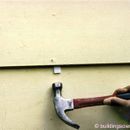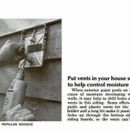Before people understood the need for a rainscreen gap

These days, conscientious builders usually install siding over a vented rainscreen gap. But back in the old days, however, wood siding was usually nailed directly to the sheathing, with only a layer of asphalt felt or housewrap between the siding and the sheathing.
When siding was installed without a rainscreen gap, the siding took a long time to dry after every rainstorm, and paint didn’t last very long.
A variety of tricks were developed to address this problem. For several years, the Building Science Corporation advised builders to retrofit small siding wedges at each clapboard lap. (See the top photo, below.)
Another method was brought to my attention by Scott Hedges, who just sent me a reproduction of a small news item from a 1972 issue of Popular Science magazine (see the bottom photo below). Interesting! Thanks, Scott.
.
GBA Detail Library
A collection of one thousand construction details organized by climate and house part











Replies
I remember installing some of those wedges on a wall with a bathroom on the interior, in about 1983 or so. The paint wouldn't stay on the siding in that spot, and this was supposed to solve the problem.